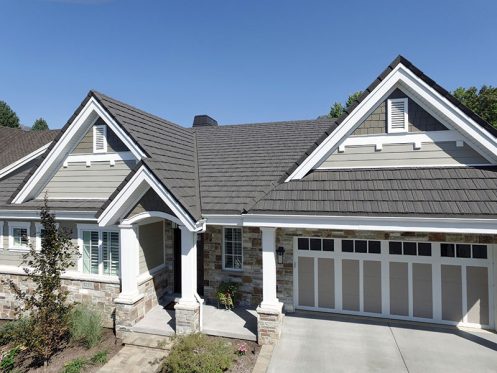Metal has grown in popularity as a roofing solution for many homes because it offers many options in terms of design. While it has been used in both interior and exterior applications for quite some time, metal has been more widely used for roofing systems in both residential and commercial properties. But does it really stack up against more tried-and-true roofing materials (such as clay and concrete tile)?
Design Differences Between Tile and Metal Roofing
Concrete roof tiles have been around for many centuries, so there’s no doubt that they will stick around for many years to come. Roof tiles can give you a virtually unlimited amount of design options, so they can be a good fit for almost any home. You can choose from a number of different options — from smooth, flat surfaces to ones with a little more dimension and texture. You can also choose from a broad selection of colors — one that will fit your home’s look and feel. And if you want to change the color scheme, later on, you can easily do it with concrete tile.
Metal is more limited in this area, while many of them are beautiful in their own right. But metal roofing has come a long way in the last several years. It can give homeowners a broader range of textures and finishes that move away from the flat appearance that metal roofs are known to have. They can now mimic the look of wood shake, asphalt shingles, and slate. But the metallic look won’t look as authentic as the real thing. The color options are also not as diverse as what you would find with roof tiles, so you may not have as much flexibility in terms of design.
What to Consider When Choosing Between Metal and Tile Roofing
The structure of a product is always important, but it’s more critical when it comes to choosing your roofing material. The main things you have to consider are longevity, resistance, and maintenance. Concrete tile can give you the amount of protection and security that many homeowners need. They can last for the life of the property, so it has a proven track record in how it can withstand even the harshest conditions. If it’s installed correctly, a tile roof can withstand the effects of rain, snow, strong winds, and even extreme heat. So, it can outperform many other roofing products.
Metal roofs can last for about 30-45 years. So while it may not last as long as tile, the material isn’t combustible (which gives it a Class A Fire Rating). There are, however, some other environmental conditions by which it might be affected. Depending on its geographical location, the surface of a metal roof can deteriorate and rust from even a minimal amount of exposure to moisture, salt, and other elements.
Some metal roof finishes can peel, chip, fade, scratch, and chalk over time. And it can be noisy during certain types of weather. A hailstorm can dent or scratch a metal roof, which can make it look unattractive. And the damage may not be covered by your property insurance. If they’re installed in areas that experience high temperatures, the metal can expand and contract (which could leave the roof without an air-tight seal). This will allow water to get into the roofing system or create a “wavy” effect.
A metal roof may seem like a low-maintenance solution, but there are many things you have to consider before you decide to have it installed. The color will start to dull after a couple of years, and it may be impossible to find a match if you need to repair it. They’re also expensive to fix because the entire sheet would have to be replaced. Because tiles can come in a number of different shades and colors, it’s not as hard to find a piece or set that matches the color of more weathered roof tiles. And depending on how many need to be replaced, the cost of repair and materials could be a lot less.
In terms of energy efficiency, metal and tile both have strong advantages over many other roofing materials. There is one important factor you have to consider, and that is how their reflective properties will affect your heating and cooling costs. While metal and tile roofs are both strong in this area, there is one that reigns supreme. The heat’s ability to move through the roof’s surface and into your attic will depend on the thickness of the material. And because it’s thicker than metal, tile has an obvious advantage.
If you want to know more about the differences between metal and tile roofing, contact Bayfront Roofing and Construction today!
